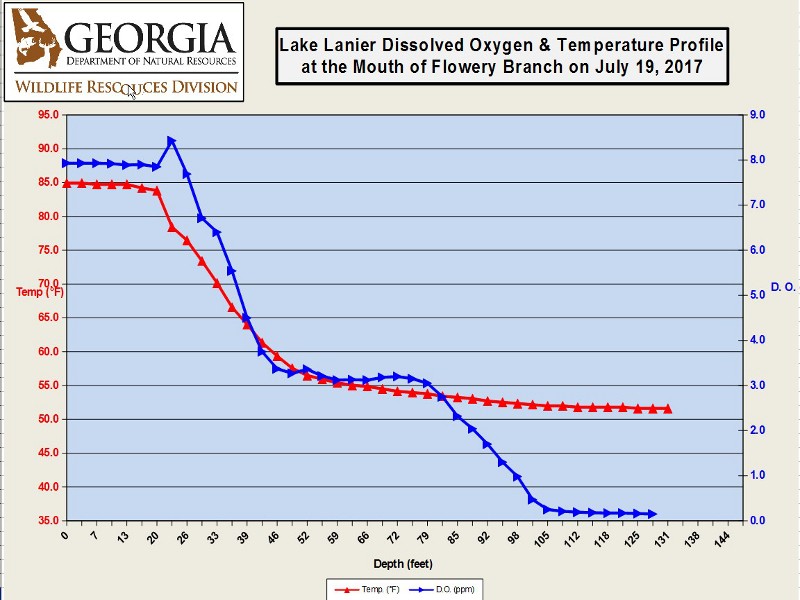Boy, do I have a new appreciation for oxygen. Yes, “O2”; that invisible stuff that keeps us alive.
I recently spent a week at 11,000-plus feet above sea level and, to be redundant, boy, do I have a new appreciation for oxygen.
Some genius family member (okay, it was me) thought a family reunion at a ski chalet on the side of Peak 7 in Breckenridge, Colorado, would be an ideal setting.
The setting was breathtaking – the scenery and the atmosphere, mostly the atmosphere.
Lightheadedness doesn’t adequately describe the sensation one gets climbing a spiral staircase to get to their loft bedroom, and guess which 66-year-old fisherman got that bedroom.
All twenty-five of us Eggers soon discovered that as long as you sat in a chair and relaxed everything was dandy. Stand up and start moving around and you were soon leaning on something or someone to avoid keeling-over.
Now what has this to do with a fishing blog?
Everything.
A couple of days ago Chris Looney, Technician, Fisheries Management, with the Wildlife Resources Division of the Georgia DNR sent me a copy of his mid-summer “Dissolved Oxygen and Temperature Profiles” for Lake Lanier.
Being a fishing nerd/geek I became a part of Chris’s email list years ago.
Several times a year Chris and his team lower instruments into the waters of north Georgia’s reservoirs to measure water temperature and dissolved oxygen content at all levels of the water column, from the surface to the lake bed.
The image at the top of this blog is the result of Chris’s visit to (as it says in the header) “the mouth of Flowery Branch on July 19, 2017”. That is an area I fish often and the graph explains why the fish are doing what they are doing at the mouth of Flowery Branch Creek.
The blue line shows that there is a spike, or sudden increase, in oxygen levels at 24-feet. The red line shows that the thermocline, or rapid decrease in water temperature, begins at 22-feet.
Remember that fish, all fish, are cold blooded; their bodies adjust to water temperature much more easily than our warm blooded human bodies do. Temperature, for a fish, is somewhat unimportant; we humans get heat stroke or suffer hypothermia if temperatures differ too greatly from our 98.6-degree norm.
Oxygen, on the other hand, is the great influencer for a fish, especially fragile fish such as shad and herring. Since they live in schools of mega-millions oxygen is used quickly and they have to find the highest concentrations of O2 or perish. Even with that being accomplished many baitfish still succumb to the conditions and flutter, dying, to the bottom.
As I fish the area around the mouth of Flowery Branch my over-priced sonar units confirm this fact. I see huge schools of bait in the 22-26-feet level of the water column. They are penned into this stratum by their need for maximum oxygen levels.
Like my recent Rocky Mountain experience, as long as we lowland-humans sit and relax the lower oxygen level is not a problem.
The larger spotted bass on the lower end of Lake Lanier like to “chill” in the comfortable water temperatures provided at 30-40 feet, usually in an area beneath the giant schools of bait that are trapped at 22-26 feet.
You’ll graph these bass, and catch these bass, at those 30-foot depths if you lower a drop shot or spoon into their lair. They like the ease of dining on dying baitfish in cool water temperatures.
Sometimes, however, their appetites demand that they go hunting. That’s why you will, on occasion, graph schools of bass in the 22-26 feet range. Their hunger has caused them to climb into the bait fish comfort zone and become active, but they can be very difficult to catch when you have your boat right over them.
Therefore, a weighed Super Fluke or “spybait”, such as the Dou Realis Swimbait 80, can be very effective when fan cast in areas where you see surface activity. Count the bait down to the 24-foot level and slowly retrieve back to the boat.
The strong top water bite we enjoyed in June has faded, so conserve your energy and limit your efforts throwing a Super Spook or Sammy because the splashes you now see are usually single fish chasing a single bait, but those splashes tell you bass are in the vicinity.
What the midday fisherman needs now is a drop shot, a spybait, a good sonar display, sunscreen and plenty of bottled water…oh, and of course, lots of O2.
Breathe deeply and enjoy the great fishing, my friends.









